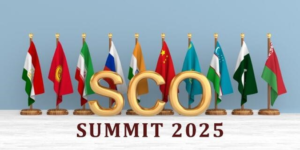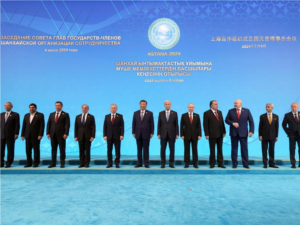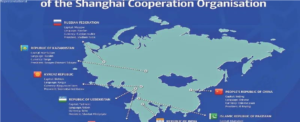The Tianjin SCO Summit: Redefining Multipolar Global Order

Introduction
The Shanghai Cooperation Organization (SCO) Summit in Tianjin (Aug 31–Sep 1, 2025) has emerged as a landmark event in international diplomacy. With more than 20 heads of state and government and 10 international organizations participating, it was the largest SCO gathering in history. Against a backdrop of shifting geopolitics, climate challenges, and economic instability, the summit projected SCO’s ambition to move from a regional security bloc to a global platform for multipolar cooperation.
Facts & Figures
- Participants: Over 20 heads of state and government (including China, Russia, India, Pakistan, Central Asian states, and observer countries).
- International Organizations: 10, including UN representatives and regional development banks.
- Agenda Highlights: Security, trade, technology, connectivity, energy, Gaza conflict, Afghanistan stability, and terrorism.
- New Partnerships: Laos elevated to dialogue partner status. Observer categories merged for streamlined governance.
- Economic Initiatives:
- Proposal for SCO Development Bank.
- Endorsement of a 2035 Development Strategy covering trade, infrastructure, and cultural cooperation.
- Expansion of BeiDou satellite system use across member states to reduce Western technological dependency.
- Security Declarations: Condemnation of terror incidents in Khuzdar and Jaffar Express (Pakistan), and a call for an inclusive ceasefire in Gaza.
- China’s Proposals: Launch of new cooperation frameworks in green energy, digital economy, AI, and vocational training.
Multilateralism in Transition
The Tianjin Summit emphasized the SCO as a counterweight to Western-dominated institutions. President Xi Jinping underscored SCO’s role in building a “fair, multipolar world order” while President Putin called for strengthening “non-Western strategic alignments” to resist sanctions and economic coercion.
At the same time, India’s Prime Minister Narendra Modi offered a cautious tone with his “SCO: Security, Connectivity, Opportunity” framework, signaling New Delhi’s desire to balance engagement with SCO while maintaining ties with the U.S. and QUAD partners.
Geopolitical Dimensions
- China’s Leadership o Pushed SCO as a platform for technology and finance independence. o Highlighted Belt and Road Initiative (BRI) linkages with SCO infrastructure projects.
- Russia’s Position o Leveraged the summit to break diplomatic isolation. o Advocated deeper defense and energy cooperation within SCO.
- India’s Balancing Act o Participated actively but avoided full alignment.
o Promoted regional trade while maintaining strategic ambiguity.
- Pakistan & Central Asia o Pakistan highlighted its counterterrorism sacrifices and need for regional energy connectivity. o Central Asian republics sought investment in infrastructure, agriculture, and climate resilience.
Institutional Vision: From Dialogue to Action
- Development Bank Proposal: Would reduce reliance on IMF/World Bank, offering financing alternatives to member states.
- BeiDou Integration: Enhances regional independence from U.S. GPS systems.
- Digital & Green Economy Platforms: Promises collaboration in AI, cybersecurity, renewable energy, and carbon-neutral initiatives.
- Youth & Culture Exchanges: Expanded scholarships and professional training under SCO umbrella.
Opportunities and Challenges
Opportunities
- Multipolarism creates space for developing countries to exercise sovereignty in decision-making.
- SCO offers a platform for counterterrorism cooperation, particularly relevant to Afghanistan and Pakistan.
- Shared projects in energy pipelines, transport corridors, and digital connectivity strengthen regional integration.
Challenges
- Divergent interests: India-China tensions, Russia’s Western confrontation, and PakistanIndia rivalry.
- Lack of binding enforcement: SCO remains a consensus-driven forum, limiting its ability to act decisively.
- Risk of over-expansion: Too many partners may dilute effectiveness.
Comparative Significance Unlike NATO or EU, the SCO thrives on sovereignty and noninterference, which makes it flexible but less binding. The Tianjin Summit demonstrated that while SCO members converge on broad anti-Western narratives, they diverge on practical policies. The balancing act between unity and rivalry remains the key test of SCO’s credibility.
Conclusion
The Tianjin SCO Summit (2025) marked a pivotal step toward shaping a multipolar, non Western international order. Its adoption of ambitious strategies—ranging from financial independence to technological cooperation—reflects growing confidence among Asian powers to redefine global governance.
However, SCO’s success will depend on whether it can move beyond symbolic declarations to tangible implementation, overcoming internal contradictions. For South Asia, Central Asia, and beyond, the summit signals that the future of international order is no longer West-centric but increasingly multipolar and Asian-centered


